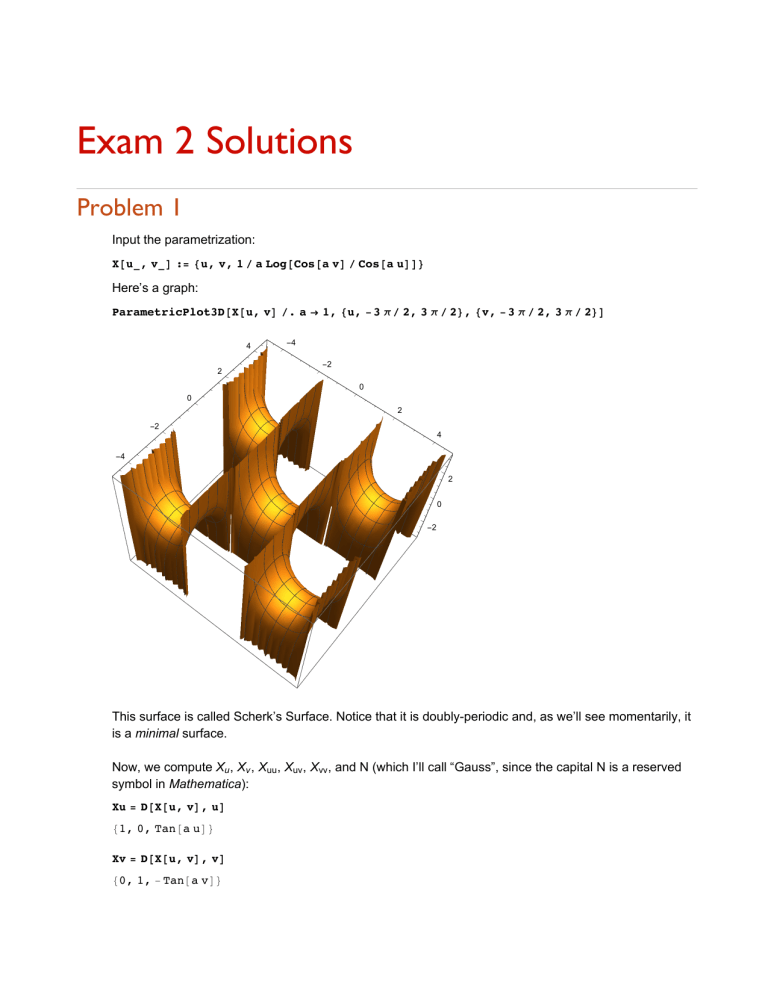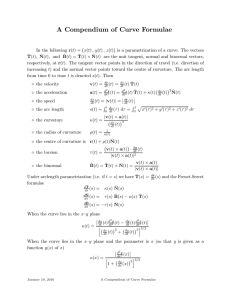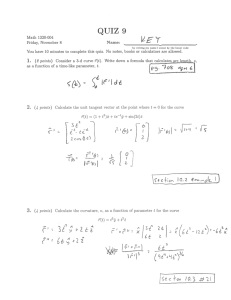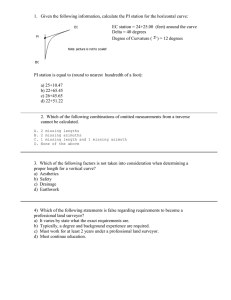������������ ���� �� �������
advertisement

����������������
���������
Input the parametrization:
�[�_� �_] �= {�� �� � / � ���[���[� �] / ���[� �]]}
Here’s a graph:
����������������[�[�� �] /� � → �� {�� - � π / �� � π / �}� {�� - � π / �� � π / �}]
This surface is called Scherk’s Surface. Notice that it is doubly-periodic and, as we’ll see momentarily, it
is a minimal surface.
Now, we compute Xu , Xv , Xuu , Xuv , Xvv , and N (which I’ll call “Gauss”, since the capital N is a reserved
symbol in Mathematica):
�� = �[�[�� �]� �]
{�� �� ���[� �]}
�� = �[�[�� �]� �]
{�� �� - ���[� �]}
2 ���
Sols.nb
��� = �[��� �]
�� �� � ���[� �]�
��� = �[��� �]
{�� �� �}
��� = �[��� �]
�� �� - � ���[� �]�
�����[��� ��]
{- ���[� �]� ���[� �]� �}
����� = % ����[�����[# � � � /@ %]]
���[� �]
-
� + ���[�
�]�
�
+ ���[�
�]�
���[� �]
� + ���[�
�]�
+ ���[�
�
�
�]�
� + ���[�
�]�
+ ���[�
�]�
From these it’s straightforward to compute E, F, G, e, f, and g (again, I can’t use a capital E, as this is
Mathematica’s symbol for the number 2.71828...):
�� = �����
� + ���[� �]�
� = �����
- ���[� �] ���[� �]
� = �����
� + ���[� �]�
� = ���������
� ���[� �]�
� + ���[� �]� + ���[� �]�
� = ���������
�
� = ���������
� ���[� �]�
-
� + ���[� �]� + ���[� �]�
And now, of course, we can just use the formulas
K=
e g - f2
E G - F2
and
H=
1 eG-2fF+gE
2
E G - F2
to get the Gaussian curvature:
Sols.nb
���
3
������������� � - � � � �� � - � � �
-
�� ���[� �]� ���[� �]�
���[� �]� + ���[� �]� �
and the mean curvature:
� / � � � - � � � + � �� �� � - � � �
-
� ���[� �]� � + ���[� �]�
� + ���[� �]� + ���[� �]�
+
� ���[� �]� � + ���[� �]�
� + ���[� �]� + ���[� �]�
� - ���[� �]� ���[� �]� + � + ���[� �]� � + ���[� �]�
������������[%]
�
Since the mean curvature is zero, this really is a minimal surface.
���������
Enter the parametrization:
�[�_� �_] �= {� ���[�]� � ���[�]� �}�
The goal is to compute the Gaussian curvature using the Gauss equation
-E K = Γ112 Γ211 + Γ212 u + Γ212 Γ221 - Γ111 Γ212 - Γ211 v - Γ211 Γ222 ,
so we need to compute the various Christoffel symbols. In turn, we can compute the Christoffel symbols
from the equations
Γ111
Γ211
Γ112
Γ212
Γ122
Γ222
E F
=
F G
Eu
Fu -
E F
F G
-1
E F
=
F G
-1
=
1
2
-1
1
2
1
2
1
2
Ev
1
2
Gu
Ev
Gu
Fv 1
2
Gv
So now we get computing:
�� = �[�[�� �]� �]
{���[�]� ���[�]� �}
�� = �[�[�� �]� �]
{- � ���[�]� � ���[�]� �}
4 ���
Sols.nb
�� = ������������[�����]
�
� = �����
�
� = ������������[�����]
��
�� = �[��� �]
�
�� = �[��� �]
�
�� = �[�� �]
�
�� = �[�� �]
�
�� = �[�� �]
��
�� = �[�� �]
�
And then solve for the Christoffel symbols:
{���� ���} = �������[{{��� �}� {�� �}}]�{� / � ��� �� - � / � ��}
{�� �}
{���� ���} = �������[{{��� �}� {�� �}}]�{� / � ��� � / � ��}
��
�
�
{���� ���} = �������[{{��� �}� {�� �}}]�{�� - � / � ��� � / � ��}
{- �� �}
And so the Gaussian curvature is:
- (��� * ��� + �[���� �] + ��� * ��� - ��� * ��� - �[���� �] - ��� * ���) / ��
�
(More precisely, Γ212 u =
-1
u2
and Γ212 Γ221 =
1
,
u2
so those two terms cancel out. Since the rest of the terms
in the numerator are 0, the whole expression is 0.)
Sols.nb
���
5
���������
Again, first enter the parametrization:
�[�_� �_] �= � α[�]
The surface is regular ⇔ X has a continuous inverse and Xu ×Xv ≠ 0. To be invertible, clearly we need
that α is injective, meaning that the curve is simple. As for Xu ×Xv ≠ 0, we compute Xu , Xv , and their
cross product:
�� = �[�[�� �]� �]
α[�]
�� = �[�[�� �]� �]
� α′ [�]
�����[��� ��]
α[�] ⨯ (� α′ [�])
Now, this will be a nonzero vector provided:
(i) α(v) ≠ 0, meaning that the curve can’t pass through the origin;
(ii) α' (v) ≠ 0, meaning that the curve is a regular curve (which was part of the assumption of the problem; and
(iii) α(v)×α' (v) ≠ 0, which means that α(v) and α' (v) can’t be parallel, or equivalently that the curve α
never travels radially outward or inward.
So the surface will be regular provided the regular curve α is simple, doesn’t pass through the origin,
and never travels radially.
Now, for the second part of the problem, we’ll want to compute Xuu , Xuv , Xvv , and N; since we’ve already
got Xu ×Xv , we can do N first:
����� = �����[α[�]� � α �[�]] (� ����[α[�]])
α[�] ⨯ (� α′ [�])
� ����[α[�]]
In fact, looking at this makes it obvious we should have just cancelled the u’s:
����� = �����[α[�]� α �[�]] ( ����[α[�]])
α[�] ⨯ α′ [�]
����[α[�]]
And then the second derivatives:
��� = �[��� �]
�
��� = �[��� �]
α′ [�]
6 ���
Sols.nb
��� = �[��� �]
� α′′ [�]
So now we can straightforwardly compute E,F,G,e,f,g:
�� = �����
α[�]�α[�]
� = �����
α[�]�(� α′ [�])
which is zero since α is parametrizedy by arclength
�=�
�
� = �����
(� α′ [�])�(� α′ [�])
� = ���������
α[�] ⨯ α′ [�]
����[α[�]]
��
which is just zero:
�=�
�
� = ���������
α[�] ⨯ α′ [�]
����[α[�]]
�α′ [�]
Also zero since α[�] ⨯ α′ [�] has to be perpendicular to α’(v).
�=�
�
� = ���������
α[�] ⨯ α′ [�]
����[α[�]]
�(� α′′ [�])
This gives us the Gaussian curvature:
� � - � � � �� � - � � �
�
It’s not so surprising that the Gaussian curvature is 0; after all, the line from the origin to any point on
the curve lies in the surface.
Also the mean curvature:
Sols.nb
���
7
� / � � � - � � � + � �� �� � - � � � // ������������
α[�]⨯α′ [�]
�(�
����[α[�]]
α′′ [�])
� (� α′ [�])�(� α′ [�])
and now we do some fancy simplifications:
������% //� �_ α �[�]��_ α �[�] ⧴ � �� �����[�_� � �_] ⧴ � �����[�� �]�
���[�_� � �_] ⧴ � ���[�� �]� ���[� / � �_� �_] ⧴ � / � (���)
α[�]⨯α′ [�]
�α′′ [�]
����[α[�]]
��
which is just
(α(v)×α' (v))·α'' (v)
2 u α(v)
���������
Consider the function g : ℝ3 → ℝ given by g(p) = p·p. Then the restriction of g to Σ is a smooth map.
Since Σ is compact, g has a global max at some point p ∈ Σ. (Another way to think of p is as follows:
since Σ is compact, it is bounded and hence contained in some very large sphere centered at the origin.
Now, let this sphere shrink until it first touches the surface: the point p is the point where this first contact occurs [really, the first contact may occur at several points simultaneously, but p is guaranteed to
be one of them]).
v . Then
Now, let
v ∈ Tp Σ and let α be a curve in Σ passing through p so that α(0) = p and α' (0) =
f (s) := g(α(s)) has a maximum at s = 0, so f ' (0) = 0 and f '' (0) ≤ 0. But, of course,
0 = f ' (0) =
d
[(f (s))]s=0
ds
=
d
[g(α(s))]s=0
ds
=
d
[α(s)· α(s)]s=0
ds
= 2 α(0)·α' (0) = 2 p ·
v.
Since
v was arbitrary, this means that p is perpendicular to Tp Σ, and hence α(0) = p = a N, where N is
the Gauss map and a ≠ 0 is a real number (if a were 0, then p would be the origin; since p was the
global max of g, that would mean Σ consisted of only a single point at the origin, which is clearly not a
regular surface).
Moreover, since f '' (0) ≤ 0, we have
0 ≥ f '' (0) =
d
[f
ds
' (s)]s=0 =
d
[2 α(s)·α' (s)]s=0
ds
In other words, a N ·α'' (0) ≤ -2
v
2
= 2 (α ' (0)·α' (0) + α(0) ·α'' (0)) = 2
v
2
+a N ·α'' (0) .
. Since the right hand side is negative, we see that N ·α'' (0) is
either always negative or always positive (depending on the sign of a).
But then this means all normal curvatures at p have the same sign, and hence that the principal curvatures k1 and k2 both have the same sign. Therefore, the Gaussian curvature is
8 ���
Sols.nb
K = k1 k2 > 0,
as desired.




